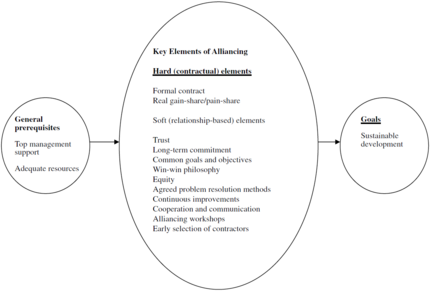Alliancing in construction
(→Definition of alliancing in construction) |
(→Definition of alliancing in construction) |
||
| Line 6: | Line 6: | ||
In the end the weaknesses of the definition and further works that should be done is discussed. | In the end the weaknesses of the definition and further works that should be done is discussed. | ||
==Definition of alliancing in construction== | ==Definition of alliancing in construction== | ||
| − | To have thorough understanding of the concept of alliancing, John F.Y. Yeung, Albert P.C. Chan, Daniel W.M. Chan (2006), went through alliancing literature and sorted out the main factors describing the concept of alliancing. These main factors were separated into three groups as illustrated in Fig. | + | To have thorough understanding of the concept of alliancing, John F.Y. Yeung, Albert P.C. Chan, Daniel W.M. Chan (2006), went through alliancing literature and sorted out the main factors describing the concept of alliancing. These main factors were separated into three groups as illustrated in Fig.<ref name="Alliancing_factors" />. |
| − | [[File:Alliancing_factors.png|430px|thumb| | + | [[File:Alliancing_factors.png|430px|thumb|Distinction of alliancing factors<ref name=Alliancing_factors />]] |
Revision as of 21:00, 12 June 2017
Abstract
In construction projects clients often outsource work. This could be due to that the workload does not justify establishing an in-house capability, or benefits by reducing information asymmetry is outweighed by the cost of internal governance. When work is outsourced there is generally an information asymmetry between the client and the supplier. Where the supplier has the expertise. This information asymmetry may lead to opportunistic behavior by the supplier. Consequently, the client might want to switch supplier. However, the costs of switching supplier are often high and include transaction costs for re-tendering, costs for associated litigation and so on. The switching costs for a supplier is often lower as interim payments are frequently used.
Alliancing is a mean to even out the imbalance in information and switching costs, and in this way minimizing the window for opportunistic behavior One problem with alliancing is the complex nature of the concept, which makes it hard to define. It is important that alliancing parties has a common understanding of concept, to avoid a cross-purposed and ineffective discussion. In a meta-study conducted in 2006 by John F.Y. Yeung, Albert P.C. Chan, and Daniel W.M. Chan gather different definitions of alliancing used in articles from scientific journals and conference proceedings, and used Ludwig Wittgenstein’s idea of family resemblance to come up with a definition for alliancing. This definition will be presented in this article. Further the five core elements of alliancing identified in the meta-study, “Formal Contract”, “Real Gain-share/Pain-share”, “Trust”, “Long-term commitment” and “Cooperation and Communication” will be discussed.
In the end the weaknesses of the definition and further works that should be done is discussed.
Definition of alliancing in construction
To have thorough understanding of the concept of alliancing, John F.Y. Yeung, Albert P.C. Chan, Daniel W.M. Chan (2006), went through alliancing literature and sorted out the main factors describing the concept of alliancing. These main factors were separated into three groups as illustrated in Fig.[1].

Cite error:
<ref> tags exist, but no <references/> tag was found